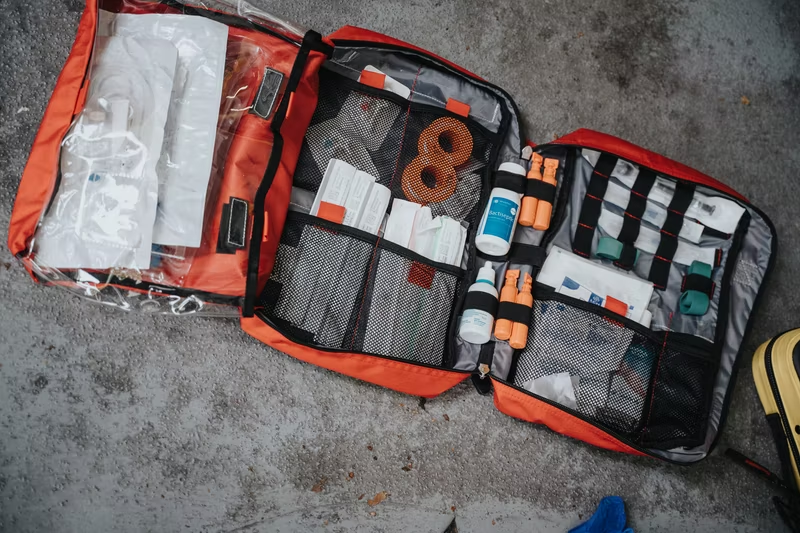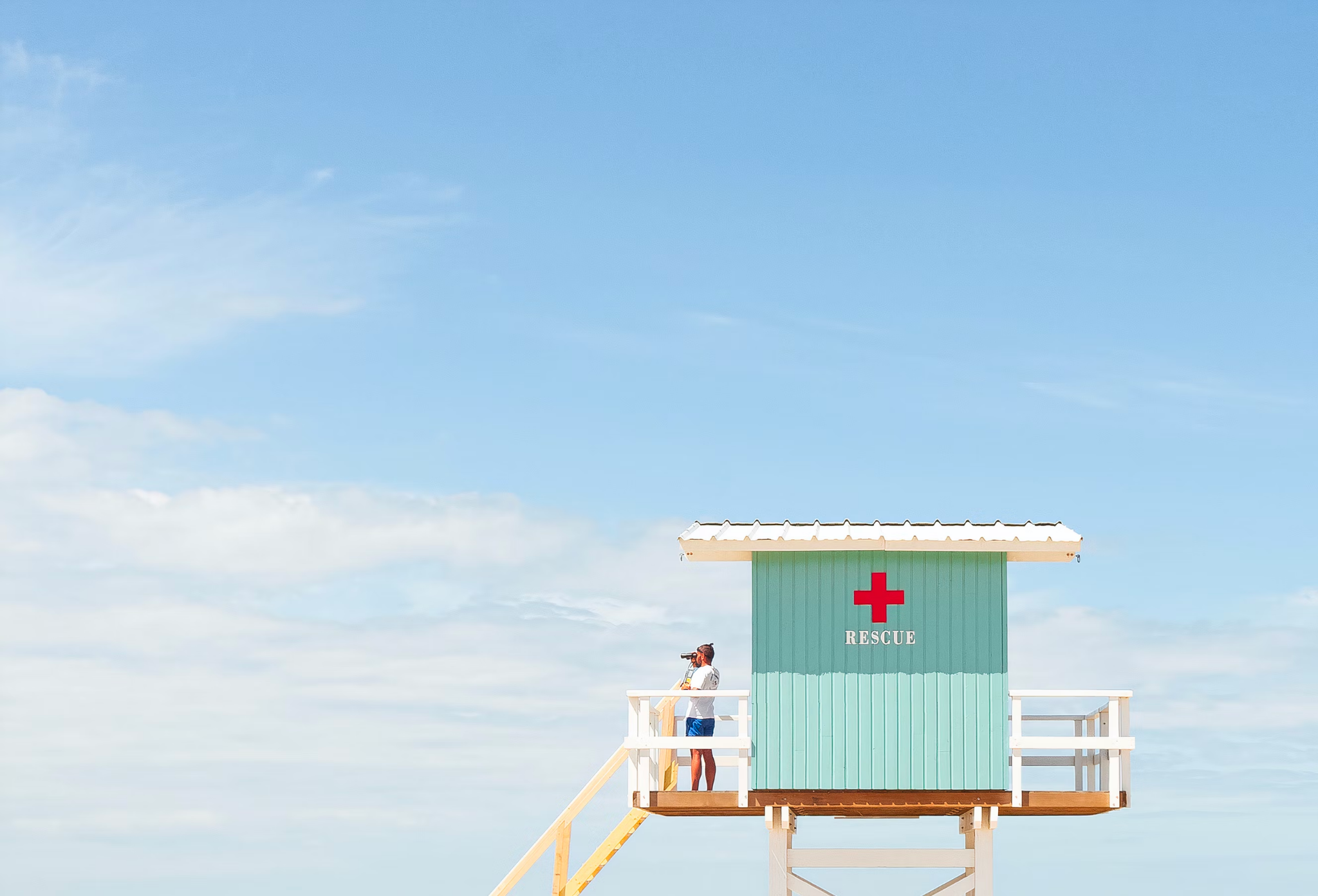The Ultimate Beach First Aid Kit: How to Build Your Own
A beach first-aid kit can mean the difference between a fun day at the beach and an absolute disaster. While you can’t handle big accidents with a beach first aid kit, it will help you be prepared to handle minor inconveniences that could ruin your fun.
Before you go out and buy an expensive first aid kit, read this article to discover how to build one at home from items you probably already have on hand. With any luck, the results will be 10x better and more useful than a store-bought first aid kit anyway!

Building a First Aid Kit for the Beach
Ready to start building your first aid kit for the beach? Here are the beach emergency items you will definitely want to have in yours.
A Bag or Container
Perhaps the hardest part of building your own emergency kit for the beach is finding something to keep all your items in. You will want a bag or container that you can permanently dedicate to this purpose so you don’t risk losing or forgetting items by taking them out and putting them back in.
You may want to collect your items first to ensure you have a bag or container that is big enough for everything. You may also want to consider a container with a clasp or latch to keep the items safe from small hands. Insulated lunch boxes tend to work well for beach first aid kits.
Bandages
You will want to have a variety of bandages on hand. You may need them for something small like a bug bite or for something large if a member of your family steps on a piece of broken glass.
You will also want to include gauze and tape to be prepared for the big scrapes. Wrap these all in plastic or put them in a small plastic bag to keep them sterile.
Scissors
Grab some bandage scissors while you are in the aisle getting your bandages. These can help to cut gauze pads or free a child from some twine they may have gotten wrapped around their foot while swimming.
Hand Sanitizer or Alcohol
No matter where you are in nature, an infection can be right around the corner, especially if your child wants to return to the water after a small scrape. Hand sanitizer or rubbing alcohol can go a long way towards cleaning a wound, as well as cleaning your hands before you assist with putting on bandages.
It’s recommended to have both rubbing alcohol in a bottle as well as in cleaning pads for wounds.
Gloves
You never know when you may need your first aid kit to treat another beachgoer who needs help. Slip in a pair of gloves or two just in case the woman on the next towel over needs some help bandaging her child’s scrape.
Tweezers
Tweezers are essential for beach safety as they are the number one way to remove tentacles from a jellyfish sting. And before you think you are heading to a beach with no jellyfish, know that almost every beach in the United States has jellyfish present at some point during the year.
Pain Relievers
Besides just scrapes, you need to be prepared for a sudden illness that could strike. An anti-inflammatory pain reliever like Advil can really help keep your day at the beach fun.
Be careful with headache medicines, however, as sometimes small children can get headaches from dehydration. This can come after they swallow too much seawater. So before giving them an NSAID, offer water and have them rest first.
Water (purified and unopened)
No, this water isn’t for drinking; rather, it is for rinsing a cut. You can also use it to clean an eye if someone gets something in their eyes like sand. Keep this bottle of water in your first aid kit and not the cooler to ensure it doesn’t get accidentally consumed.
Saline Solution
Speaking of rinsing out eyes, better slip some saline solution into your first aid kit. You never know when a kiddo might decide to open their eyes underwater or rub something unsavory in them. Saline solution can really help relieve whatever eye pain you may encounter at the beach.
Sunscreen
Although you should be bringing sunscreen NOT in your first aid kit, it is also a good idea to have some in your first aid kit just in case you run out. Sunburns can be serious depending on your skin type, and it’s critical to have extra on hand.
Aloe Vera
Try as you might to avoid a sunburn, it can still happen while you are at the beach. Bring the aloe vera in case this happens to you so you can apply it for quick relief. Like sunscreen, you should have this both in your beach first aid kit as well as some for normal use.
Vinegar
If your kid gets stung by a jellyfish, do not pee on them. This is a rumor and will do nothing for your friend. Instead, keep a small bottle of vinegar and pour this on their wound as it will neutralize the poison from the jellyfish sting.
Anti-Itch Cream
Unfortunately, there are critters at the beach. From sand flies to mosquitos, it’s likely you will get bitten by something if you don’t use bug spray (which we recommend that you do!) But pack anti-itch cream regardless to keep your kids from itching. Scratching bug bites opens the wounds and can cause kids and adults alike to get infections.
Eardrops
There is nothing more annoying than getting water in your ears. While you may never need to use this, it’s still a great idea to put in your emergency beach kit for the off chance you get water in your ear and would like to not feel uncomfortable.
Benadryl
Carrying an EpiPen can be expensive and difficult because they need to be stored somewhere cool. Instead, we recommend putting a couple of packets of Benadryl in your first aid kit. While they won’t save a kid if they have a life-threatening reaction, they can stop minor to mid-range reactions like if your child gets ahold of food they are allergic to.
Remember, whenever anyone is experiencing an allergic reaction, you should contact a lifeguard or call the emergency number right away.

Poison Ivy Spray
Yes, there might be poison ivy at many beaches in the southern United States. Keep some of this spray in your bag to spray on the affected area after exposure. This is also something you should include if you want your beach first aid kit to be universal for camping and hikes as well.
Ace Bandage
As weird as it may seem, some sort of bandage in your first aid kit can be helpful if someone sprains an ankle or pulls a tendon. While you should always have this injury checked out by a doctor as well, wrapping it in the meantime can make it easier to get to the car as beaches typically aren’t very close to the parking lot.
Disposable Ice Packs
Disposable ice packs come in the same form as heat packs and can be cracked and applied to an injury when needed. You can use them for heat-related issues like heat stroke or to help with a sprained ankle or twisted wrist.
Backup Medications
If you have a child who has asthma, or a severe allergy that requires an Epi pen, it is a good idea to spend a little extra money and have backups in the first aid kit. You never know when something may go wrong, and you may need it.
Be aware, however, that these medications are temperature sensitive, so when you get home from the beach, the extras should be removed and placed somewhere else for storage if you won’t be going to the beach anytime soon.
Rehydration Salts
Commonly found in wilderness stores, rehydration salts can be helpful when facing conditions like dehydration. While you likely won’t be far enough from society to need these while at the beach, you never know, so it’s a good idea to include them. Plus, when you do, this makes your beach first aid kit hiking friendly, so you can use it for all situations you come across.
Final Thoughts on the Ultimate Beach First Aid Kit
As you can see, it isn’t very hard at all to make your own beach first aid kit. Plus, once you do, you can use it as a first aid kit for other activities as well. Just be sure to pack it in an appropriate bag that is waterproof and beach safe, and you’ll be glad to have these items on hand the next time you are faced with a beach emergency!
It is also a good idea to look up the emergency numbers of any beach you may be visiting. In the US, the emergency number is 911, while in Europe, it is usually 112.
Link/Reference This Article
If you found the information in this article useful in your research, please link to use as the source using the tool below.
-
<a href="http://seatemperatures.net/blog/beach-first-aid-kit/">The Ultimate Beach First Aid Kit: How to Build Your Own</a>
-
"The Ultimate Beach First Aid Kit: How to Build Your Own". SeaTemperatures.net. Accessed on April 24, 2024. http://seatemperatures.net/blog/beach-first-aid-kit/.
-
"The Ultimate Beach First Aid Kit: How to Build Your Own". SeaTemperatures.net, http://seatemperatures.net/blog/beach-first-aid-kit/. Accessed 24 April, 2024
-
The Ultimate Beach First Aid Kit: How to Build Your Own. SeaTemperatures.net. Retrieved from http://seatemperatures.net/blog/beach-first-aid-kit/.